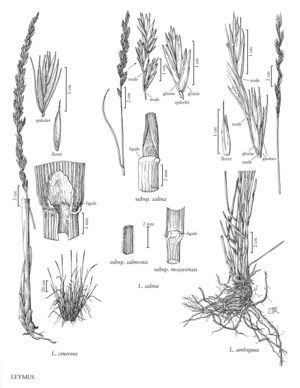Leymus ambiguus
Plants loosely cespitose, occasionally rhizomatous. Culms 60-110 cm tall, 1-1.5 mm thick, many together. Leaves exceeded by the spikes; sheaths glabrous or sparsely pubescent; auricles to 1.1 mm; ligules 0.2-1.2 mm, truncate; blades 2.5-6 mm wide, flat, adaxial surfaces scabridulous, glabrous, veins (9)11-17, unequal, not crowded. Spikes 8-17 cm long, 5-10 mm wide, erect, with 2 spikelets at most nodes; internodes 4-11 mm, surfaces hairy distally, hairs 0.2-0.8 mm, edges ciliate. Spikelets 12-23 mm, with 2-7 florets. Glumes unequal, 0.5-2.5 mm wide, tapering from below midlength to the subulate apices, stiff, keeled, the central portion thicker than the margins, glabrous, scabrous, particularly distally, bases not overlapping, 0-1(3)-veined, veins inconspicuous at midlength; lower glumes 2-9.5 mm; upper glumes 6-14 mm; calluses with hairs, hairs about 0.2 mm; lemmas 8-14.5 mm, glabrous or sparsely strigose, awned, awns 1.3-7 mm; anthers 3.5-7 mm, dehiscent. 2n = 28.
Distribution
Mont., Colo., N.Mex., Wyo.
Discussion
Leymus ambiguus grows on steep, often boulder-strewn hillsides at scattered locations in Colorado and New Mexico.
Selected References
None.
